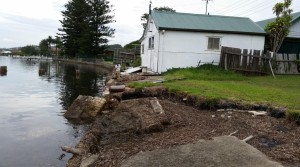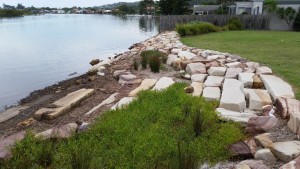 Home owners who live on the foreshore of a lake, the bank of a stream or close to the ocean face an on-going dilemma – how do I protect my assets from the impacts of storm events and predicted sea level rise while maintaining good access to the waterway and meeting my environmental obligations?
Home owners who live on the foreshore of a lake, the bank of a stream or close to the ocean face an on-going dilemma – how do I protect my assets from the impacts of storm events and predicted sea level rise while maintaining good access to the waterway and meeting my environmental obligations?
This is further compounded by the fact that the approval process can be a frustrating and time consuming process for many homeowners.
Irrespective of whether you are building a marina with a significant environmental impact, or doing environmental restoration work, the requirements of the approval authorities are much the same.
Yes this is a complex process – it is complex, time consuming and can be frustrating. Yet environmental restoration work in and around our waterways is important and it needs to be carried out in the spirit of the legislation and best practice methodologies to protect these sensitive environments.
The April 2015 storm in the Hunter region caused millions of dollars damage to people’s homes, boats, public reserves, parks and foreshores and four people died in the township of Dungog. The post storm clean-up took many months and some jobs remain outstanding. Unprotected foreshore areas around Lake Macquarie were hit badly with many home owners losing metres of their land and in some instances their assets.
Predicted changes to our climate and sea level rise will exacerbate foreshore erosion processes resulting in the loss of more land, assets and negative impacts on water quality. These impacts will affect seagrass, fish habitat and ecological processes within the waterway.
How can I permanently protect my foreshore land and my assets?
Finding an appropriately qualified professional to design and build resilience into your shoreline is the best way to secure a long term solution.
The most robust, eco-friendly and visually pleasing designs incorporate natural, locally sourced materials and plants – such as sandstone blocks and native plants. These ‘living shorelines’ have design features that incorporate habitat for marine animals, and very importantly – are resilient to storms and predicted sea level rise. A common feature of these designs is to provide easy access to the waterway. This also increases the value of your property.
Environmentally friendly ‘sea walls’ should be designed with all of the features outlined above and should be designed to cope with the predicted sea level rise on the NSW coast of 0.4m by 2050 and 0.9m by 2100.
Look at this shoreline in Lake Macquarie after its restoration.
If you would like to find out more please contact Trevor Cameron at Eikos Environment and Heritage on www.eikos.com.au or email trevor@eikos.com.au
